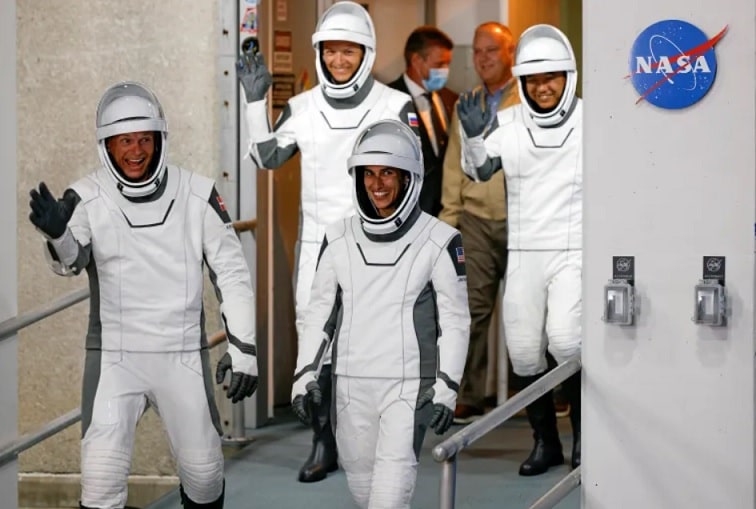What’s in today’s article?
- Why in news?
- What is International Space Station (ISS)?
- What are the features of ISS?
- Why Is the Space Station Important?
- News Summary: NASA, SpaceX launch sends four astronauts from four countries to ISS
- Why has such a diverse group of astronauts gone to ISS?
- What is the mission?
Why in news?
- NASA and SpaceX’s Dragon spacecraft has blasted off carrying four astronauts to the International Space Station (ISS).
- Known as Crew-7, the mission includes four astronauts from four countries – the US, Denmark, Japan, and Russia.
- This was the first US take-off in which all the astronauts atop the spacecraft belonged to a different country.
- Until now, NASA had always included two or three of its own on its SpaceX flights.
- This was the first US take-off in which all the astronauts atop the spacecraft belonged to a different country.
International Space Station (ISS)
- ISS is a large spacecraft in low Earth orbit largely by the United States and Russia, with assistance and components from a multinational consortium.
- It is habitable spacecraft that orbits Earth at an average altitude of approximately 420 kilometers (260 miles).
- It serves as a unique and collaborative space laboratory, research facility, and living space for astronauts and cosmonauts from various countries.
Features of ISS
- Construction and Ownership
- The ISS is a joint project involving space agencies from multiple countries.
- The major partners include NASA (United States), Roscosmos (Russia), ESA (European Space Agency), JAXA (Japan Aerospace Exploration Agency), and CSA (Canadian Space Agency).
- In 2022, Russia announced that it will pull out of ISS after 2024 and focus on building its own orbiting outpost.
- These agencies have contributed modules, components, and resources to construct and maintain the station.
- Size and Structure
- The ISS is quite large, with a mass of around 460 tons and a habitable volume roughly equivalent to the interior of a Boeing 747 aircraft.
- It consists of various interconnected modules and components, including laboratories, living quarters, and docking ports.
- Orbit and Duration
- It travels at 17,500 mph. This means it orbits Earth every 90 minutes.
- This means that crew members on board experience multiple sunrises and sunsets each day.
- Missions typically last six months, although some crew members may stay for shorter or longer durations.
- It travels at 17,500 mph. This means it orbits Earth every 90 minutes.
- International Crew
- The ISS is continuously inhabited by a rotating crew of astronauts and cosmonauts from different nations.
- These crew members live and work on the station for several months at a time, conducting experiments, maintaining systems, and performing various tasks necessary to keep the station operational.
Why Is the Space Station Important?
- One of the primary purposes of the ISS is to conduct scientific research and experiments in the unique microgravity environment of space.
- Microgravity is often referred to as near zero gravity or weightlessness.
- Researchers from around the world use the station to study a wide range of fields, including biology, physics, astronomy, and Earth sciences.
- The ISS has contributed to our understanding of topics such as human health in space, materials science, and climate change.
- The space station has made it possible for people to have an ongoing presence in space. Human beings have been living in space every day since the first crew arrived.
News Summary: NASA, SpaceX launch sends four astronauts from four countries to ISS
Why has such a diverse group of astronauts gone to ISS?
- The Crew-7 mission is a result of the ongoing cooperation among different countries in space, especially since the launch of the space station in 1998.
- ISS Program involves the US, Russia, Canada, Japan, and the participating countries of the European Space Agency.
- It is one of the most ambitious international collaborations ever attempted.
What is the mission?
- The Crew-7 is the eighth flight operated by NASA and Elon Musk-owned SpaceX as part of the agency’s commercial crew program, which has been taking astronauts to the ISS since SpaceX’s first crewed mission in 2020.
- During their stay at the space station, the Crew-7 astronauts will conduct more than 200 science experiments and technology demonstrations to prepare for missions to the Moon, Mars, and beyond.
- The research will include a collection of microbial samples from the exterior of the space station.
- The team will also analyse how sleeping in the microgravity environment differs from Earth by examining astronauts’ brain waves while they sleep.
- Another experiment will look at the formation of biofilms in wastewater on the space station, which could be key to finding better ways to recycle water for drinking and hygiene while in space.
Q1) What is microgravity?
Microgravity, often referred to as “zero gravity” or “weightlessness,” is the condition in which objects appear to be weightless and free-fall freely in a spacecraft or other environment, such as the International Space Station (ISS). It occurs when an object is in a state of continuous free fall towards a massive body, like the Earth, but is also moving forward at a sufficient velocity that it never actually hits the Earth’s surface. This combination of falling towards the Earth while moving forward at the right speed creates the sensation of weightlessness for objects and occupants within the spacecraft.
Q2) What is JAXA?
JAXA, or the Japan Aerospace Exploration Agency, is Japan’s national space agency responsible for space research, exploration, and the development of space technology. Established on October 1, 2003, JAXA is a prominent player in the global space community and conducts a wide range of activities related to space science, satellite development, planetary exploration, and human spaceflight.
Source: NASA, SpaceX send astronauts from four nations to space station: Who are they, what is the mission | NASA | Britannica | Aljazeera
Last updated on January, 2026
→ Check out the latest UPSC Syllabus 2026 here.
→ Join Vajiram & Ravi’s Interview Guidance Programme for expert help to crack your final UPSC stage.
→ UPSC Mains Result 2025 is now out.
→ UPSC Notification 2026 is scheduled to be released on January 14, 2026.
→ UPSC Calendar 2026 has been released.
→ UPSC Prelims 2026 will be conducted on 24th May, 2026 & UPSC Mains 2026 will be conducted on 21st August 2026.
→ The UPSC Selection Process is of 3 stages-Prelims, Mains and Interview.
→ Prepare effectively with Vajiram & Ravi’s UPSC Prelims Test Series 2026 featuring full-length mock tests, detailed solutions, and performance analysis.
→ Enroll in Vajiram & Ravi’s UPSC Mains Test Series 2026 for structured answer writing practice, expert evaluation, and exam-oriented feedback.
→ Join Vajiram & Ravi’s Best UPSC Mentorship Program for personalized guidance, strategy planning, and one-to-one support from experienced mentors.
→ UPSC Result 2024 is released with latest UPSC Marksheet 2024. Check Now!
→ UPSC Toppers List 2024 is released now. Shakti Dubey is UPSC AIR 1 2024 Topper.
→ Also check Best UPSC Coaching in India

















